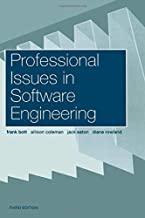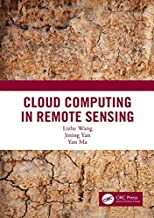PROFESSIONAL ISSUES IN SOFTWARE ENGINEERING
Original price was: ₹7,430.22.₹5,944.18Current price is: ₹5,944.18.
ISBN: 9780748409518
Author/Editor: ROWLAND
Publisher: CRC Press
Year: 2001
1 in stock (can be backordered)
Description
Nowadays software engineers not only have to worry about the technical knowledge needed to do their job, but they are increasingly having to know about the legal, professional and commercial context in which they must work. With the explosion of the Internet and major changes to the field with the introduction of the new Data Protection Act and the legal status of software engineers, it is now essential that they have an appreciation of a wide variety of issues outside the technical.
Equally valuable to both students and practitioners, it brings together the expertise and experience of leading academics in software engineering, law, industrial relations, and health and safety, explaining the central principles and issues in each field and shows how they apply to software engineering.
Additional information
| Weight | 0.522 kg |
|---|
Product Properties
| Year of Publication | 2001 |
|---|---|
| Table of Contents | Acknowledgments xv Prologue xvii Chapter 1 Profit from Accurate Forecasting 1 1.1 The Importance of Demand Forecasting 2 1.2 When Is a Forecast Not a Forecast? 2 1.3 Ways of Presenting Forecasts 3 1.3.1 Forecasts as Probability Distributions 3 1.3.2 Point Forecasts 4 1.3.3 Prediction Intervals 6 1.4 The Advantages of Using Dedicated Demand Forecasting Software 7 1.5 Getting Your Data Ready for Forecasting 8 1.6 Trading-Day Adjustments 10 1.7 Overview of the Rest of the Book 11 1.8 Summary of Key Terms 12 1.9 References 13 Chapter 2 How Your Software Finds Patterns in Past Demand Data 15 2.1 Introduction 16 2.2 Key Features of Sales Histories 16 2.2.1 An Underlying Trend 16 2.2.2 A Seasonal Pattern 17 2.2.3 Noise 22 2.3 Autocorrelation 23 2.4 Intermittent Demand 25 2.5 Outliers and Special Events 25 2.6 Correlation 27 2.7 Missing Values 30 2.8 Wrap-Up 31 2.9 Summary of Key Terms 31 Chapter 3 Understanding Your Software's Bias and Accuracy Measures 33 3.1 Introduction 34 3.2 Fitting and Forecasting 34 3.2.1 Fixed-Origin Evaluations 36 3.2.2 Rolling-Origin Evaluations 36 3.3 Forecast Errors and Bias Measures 38 3.3.1 The Mean Error (ME) 39 3.3.2 The Mean Percentage Error (MPE) 40 3.4 Direct Accuracy Measures 40 3.4.1 The Mean Absolute Error (MAE) 40 3.4.2 The Mean Squared Error (MSE) 41 3.5 Percentage Accuracy Measures 42 3.5.1 The Mean Absolute Percentage Error (MAPE) 42 3.5.2 The Median Absolute Percentage Error (MDAPE) 44 3.5.3 The Symmetric Mean Absolute Percentage Error (SMAPE) 44 3.5.4 The MAD/MEAN Ratio 45 3.5.5 Percentage Error Measures When There Is a Trend or Seasonal Pattern 46 3.6 Relative Accuracy Measures 46 3.6.1 Geometric Mean Relative Absolute Error (GMRAE) 47 3.6.2 The Mean Absolute Scaled Error (MASE) 48 3.6.3 Bayesian Information Criterion (BIC) 49 3.7 Comparing the Different Accuracy Measures 50 3.8 Exception Reporting 52 3.9 Forecast Value-Added Analysis (FVA) 52 3.10 Wrap-Up 55 3.11 Summary of Key Terms 56 3.12 References 57 Chapter 4 Curve Fitting and Exponential Smoothing 59 4.1 Introduction 60 4.2 Curve Fitting 60 4.2.1 Common Types of Curve 60 4.2.2 Assessing How Well the Curve Fits the Sales History 63 4.2.3 Strengths and Limitations of Forecasts Based on Curve Fitting 64 4.3 Exponential Smoothing Methods 65 4.3.1 Simple (or Single) Exponential Smoothing 65 4.3.2 Exponential Smoothing When There Is a Trend: Holt's Method 68 4.3.3 The Damped Holt's Method 70 4.3.4 Holt's Method with an Exponential Trend 72 4.3.5 Exponential Smoothing Where There Is a Trend and Seasonal Pattern: The Holt-Winters Method 73 4.3.6 Overview of Exponential Smoothing Methods 74 4.4 Forecasting Intermittent Demand 74 4.5 Wrap-Up 77 4.6 Summary of Key Terms 78 Chapter 5 Box-Jenkins ARIMA Models 81 5.1 Introduction 82 5.2 Stationarity 82 5.3 Models of Stationary Time Series: Autoregressive Models 85 5.4 Models of Stationary Time Series: Moving Average Models 87 5.5 Models of Stationary Time Series: Mixed Models 88 5.6 Fitting a Model to a Stationary Time Series 89 5.7 Diagnostic Checks 91 5.7.1 Check 1: Are the Coefficients of the Model Statistically Significant? 91 5.7.2 Check 2: Overfitting-Should We Be Using a More Complex Model? 92 5.7.3 Check 3: Are the Residuals of the Model White Noise? 92 5.7.4 Check 4: Are the Residuals Normally Distributed? 93 5.8 Models of Nonstationary Time Series: Differencing 94 5.9 Should You Include a Constant in Your Model of a Nonstationary Time Series? 96 5.10 What If a Series Is Nonstationary in the Variance? 97 5.11 ARIMA Notation 97 5.12 Seasonal ARIMA Models 98 5.13 Example of Fitting a Seasonal ARIMA Model 101 5.14 Wrap-Up 104 5.15 Summary of Key Terms 105 Chapter 6 Regression Models 109 6.1 Introduction 110 6.2 Bivariate Regression 110 6.2.1 Should You Drop the Constant? 113 6.2.2 Spurious Regression 114 6.3 Multiple Regression 115 6.3.1 Interpreting Computer Output for Multiple Regression 115 6.3.2 Refitting the Model 119 6.3.3 Multicollinearity 119 6.3.4 Using Dummy Predictor Variables in Your Regression Model 123 6.3.5 Outliers and Influential Observations 127 6.4 Regression Versus Univariate Methods 129 6.5 Dynamic Regression 131 6.6 Wrap-Up 132 6.7 Summary of Key Terms 132 6.8 Appendix: Assumptions of Regression Analysis 134 6.9 Reference 136 Chapter 7 Inventory Control, Aggregation, and Hierarchies 137 7.1 Introduction 138 7.2 Identifying Reorder Levels and Safety Stocks 139 7.3 Estimating the Probability Distribution of Demand 142 7.3.1 Using Prediction Intervals to Determine Safety Stocks 144 7.4 What If the Probability Distribution of Demand Is Not Normal? 146 7.4.1 The Log-Normal Distribution 146 7.4.2 Using the Poisson and Negative Binomial Distributions 148 7.5 Temporal Aggregation 151 7.6 Dealing with Product Hierarchies and Reconciling Forecasts 154 7.6.1 Bottom-Up Forecasting 154 7.6.2 Top-Down Forecasting 155 7.6.3 Middle-Out Forecasting 157 7.6.4 Hybrid Methods 157 7.6.5 Issues and Future Developments 158 7.7 Wrap-Up 159 7.8 Summary of Key Terms 160 7.9 References 161 Chapter 8 Automation and Choice 163 8.1 Introduction 164 8.2 How Much Past Data Do You Need to Apply Different Forecasting Methods? 165 8.3 Are More Complex Forecasting Methods Likely to Be More Accurate? 168 8.4 When It's Best to Automate Forecasts 169 8.5 The Downside of Automation 173 8.6 Wrap-Up 174 8.7 References 175 Chapter 9 Judgmental Interventions: When Are They Appropriate? 177 9.1 Introduction 178 9.2 Psychological Biases That Might Catch You Out 179 9.2.1 Seeing Patterns in Randomness 179 9.2.2 Recency Bias 180 9.2.3 Hindsight Bias 181 9.2.4 Optimism Bias 181 9.3 Restrict Your Interventions 183 9.3.1 Large Adjustments Perform Better 183 9.3.2 Focus Your Efforts Where They'll Count 184 9.4 Making Effective Interventions 185 9.4.1 Divide and Conquer 185 9.4.2 Using Analogies 186 9.4.3 Counteracting Optimism Bias 187 9.4.4 Harnessing the Power of Groups of Managers 189 9.4.5 Record Your Rationale 192 9.5 Combining Judgment and Statistical Forecasts 192 9.6 Wrap-Up 194 9.7 Reference 194 Chapter 10 New Product Forecasting 195 10.1 Introduction 196 10.2 Dangers of Using Unstructured Judgment in New Product Forecasting 197 10.3 Forecasting by Analogy 198 10.3.1 Structured Analogies 198 10.3.2 Applying Structured Analogies 199 10.4 The Bass Diffusion Model 203 10.4.1 Innovators and Imitators 203 10.4.2 Estimating a Bass Model 204 10.4.3 Limitations of the Basic Bass Model 206 10.5 Wrap-Up 207 10.6 Summary of Key Terms 208 10.7 References 209 Chapter 11 Summary: A Best Practice Blueprint for Using Your Software 211 11.1 Introduction 212 11.2 Desirable Characteristics of Forecasting Software 212 11.2.1 Data Preparation 212 11.2.2 Graphical Displays 212 11.2.3 Method Selection 214 11.2.4 Implementing Methods 215 11.2.5 Hierarchies 215 11.2.6 Forecasting with Probabilities 215 11.2.7 Support for Judgment 216 11.2.8 Presentation of Forecasts 216 11.3 A Blueprint for Best Practice 217 11.4 References 218 Index 219 |
| Author | ROWLAND |
| ISBN/ISSN | 9780748409518 |
| Binding | n/a |
| Edition | 3 |
| Publisher | CRC Press |
You must be logged in to post a review.






Reviews
There are no reviews yet.